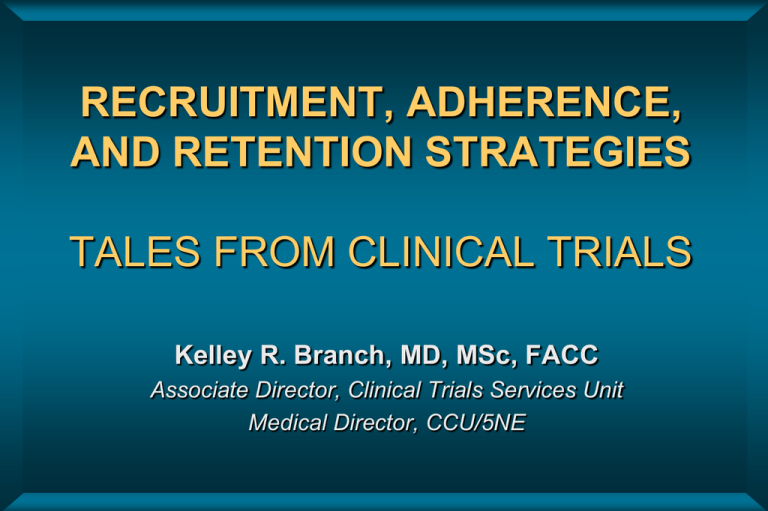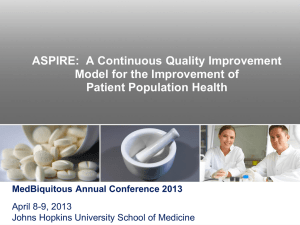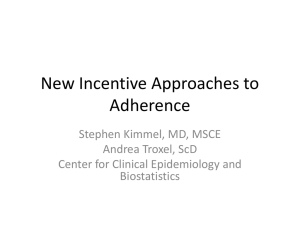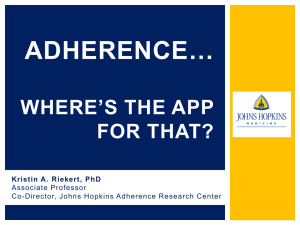
RECRUITMENT, ADHERENCE,
AND RETENTION STRATEGIES
TALES FROM CLINICAL TRIALS
Kelley R. Branch, MD, MSc, FACC
Associate Director, Clinical Trials Services Unit
Medical Director, CCU/5NE
A Clinical Trial Story…
Once upon a time, there were 4
hypertension trials…
COMPARISON OF SHEP, STOP-H,
MRC-92 AND SYST-EUR CHARACTERISTICS
SHEP
STOP-H
MRC-92
Syst-Eur
Sample Size
4736
1627
4396
4695
Mean Age
71.5
75.6
70.3
70.3
160-219
180-230
160-209
160-219
BP
SBP
Criteria
DBP
Primary
Outcome
Design
<90
90+
<114
<95
Total Stroke Total mortality Total stroke Total stroke
P R DB
P R DB
P R SB
P R DB
Sys-Eur Trial: Accrual
Trial Adherence
Mean F/U Time
SHEP
54 mo
STOP-H
25 mo
MRC-92
70 mo
Syst-Eur
30 mo
Mean Baseline BP
170/77
190/104
185/91
174/86
14/6
11/5
BP Differential
41247.00
19.5/8
Adherence
Lost to F/U
6%
0%
25%
% Crossovers
33%
23%
31%
52%D
37%B
47%P
% Adherence
90%/67% 84%/77%
P 5% (116)
A 5% (121)
23%
85%/72%
SYST - EUR
A WORST CASE ANALYSIS?
600
500
STROKE
507
CHD
TOTAL EVENTS
Number
400
Late
Recruitment
= Fewer Events
LOST TO
FOLLOW-UP
300
262
237
High Lost to Follow
Up = No 245
Definitive
200
Conclusions
from the Trial
131
255
124
100
10
0
SYST-EUR
SHEP
6
Major Trial Issues
• Recruitment - Timely Enrollment
• Adherence
• Complete Follow Up
RECRUITMENT
MANTRA: “Get Sufficient
Population In a Reasonable
Time”
RECRUITMENT
FUNDAMENTAL POINT
Successful recruitment depends on developing
a careful plan with multiple strategies,
maintaining flexibility, establishing interim
goals and preparing to devote the necessary
effort.
Friedman, Furberg and DeMets
RECRUITMENT
• Successful recruitment has been
documented in many trials
• Clinical Sites: Past performance predicts
future
• Centers carefully selected by past
performance
(http://www.fhcrc.org/science/phs/swog/recrcct/)
RECRUITMENT:BASIC ISSUES
• Planning
– Sources and support
– Strategies
•
•
•
•
•
Conduct - Implementation
Monitoring - Short and long term goals
Problems - Expect them to happen
Solutions - Make them occur
Have reasons for participation
RECRUITMENT: CAREFUL
PLANNING
•
•
•
•
BE CONSERVATIVE IN YOUR ESTIMATES
Design easy recruitment
Establish interim goals
Have contingency plans
• 3 TO 6 MONTH PERIOD TO SEE RESULTS
TRIAL PLANNING
•
•
•
•
•
•
•
•
Increase likelihood of getting sufficient participants
Staff – Organized, experienced
Institutional support - proper facilities
Publicity - start before trial
Multiple recruitment strategies - at least 3
Pilot test strategies
Contingency plans
Statistical power - assumes constant enrollment
ADVANTAGES: WIDE ENTRY
CRITERIA
• Easier screening and recruitment
• More feasible and affordable
• Broader range of variables and larger study size
• Reliable overall result
• Greater public health impact
• Testing subgroup hypotheses
14
RECRUITMENT DATA: Variable
Success in 13 NHLBI Studies
Study
AMIS
BHAT
CAPS
CARDIA
CDP
CSSCD
HDFP
LRC
MILIS
MRFIT
POSCH
SHEP Pilot
TIMI-1*
Number of Participants
Recruited
Actual
Actual/Planned
4,524
3,837
502
5,182
8,345
3,241
10,940
3,843
985
12,886
838
551
316
1.06
0.95
1.00
1.02
1.00
1.01
1.04
1.08
0.82
1.07
0.84
1.10
0.93
Person-Years in
Recruitment
Planned Recruitment
Time
Period
Actual/Planned Actual/Planned (R)
1.00
1.21
1.08
1.00
1.22
1.13†
1.50
1.54
2.71
1.13†
1.58†
1.17
0.96
*TIM-1 was stopped on the recommendation of Data and Safety Monitoring
Committee; the treatment showed strong evidence of efficacy.
† The ‘projected’ time was revised after additional clinics joined the study.
0.83
0.82
0.82
0.86
0.55
1.16
1.02
0.34
0.35
0.81
0.25
0.71
0.98
16
SELECT Trial Accrual
Projected and Actual
SELECT Accrual
Actual and Projected Accrual vs. Estimated Accrual
40000
35000
30000
Actual accrual as of
March 31, 2004: 24,166
Reach accrual goal of 32,400 at
end of April 2004
25000
Actua
Proje
20000
Estim
15000
10000
5000
0
Projected
ACCORD Initial Trial
ACCORD Main Trial Accrual
10000
80
9000
70
Number Randomized
60
7000
50
6000
5000
40
4000
30
3000
20
2000
1000
ACTUAL
GOAL
0
150
140
130
120
110
100
90
80
70
60
50
40
30
20
10
0
Weeks
0
Number of Sites Active
8000
RECRUITMENT STRATEGIES (N=3)
How to Get Patients
Chart Review
Websites
Media Efforts
Registries
Direct Mail
Blood Bank Donors
Mass Screening
Screening
Occupational
Laboratory Lists
Medical Referrals
20
Checklist: OVERALL
RECRUITMENT PROGRAM
Start recruitment on target date
Choose physically accessible location
Use at least three recruitment strategies
Recruitment Coordinator - overall responsibility
Trial-wide recruitment coordinator network
Accurate tracking system
Match staff and screenees
OVERALL RECRUITMENT
PROGRAM
Provide staff back-up
Be aware and anticipate staff burnout
Inform medical and lay communities
Recruits - Solicit in simple language
Medical associations and hospital staffs contacted by the Principal Investigator
OVERALL RECRUITMENT
PROGRAM
Identify excellent, experienced staff
Calendar for ENTIRE recruitment period
Pretest your recruitment strategies
Regular review and evaluation of program
Develop contingency plans
Flexible clinic hours
PATIENT REASONS FOR
PARTICIPATION
• Answer scientific question accurately
• Altrusim: Benefit other patients - current and
future
• Benefit to themselves
– additional monitoring
– second opinion of their condition
– reassurance regarding diagnosis
24
RECRUITMENT OF STUDY
POPULATION
MANTRA: “Get Sufficient Population
In a Reasonable Time”
RECRUITMENT FAILURE CAUSES:
• Late start
• Inadequate planning
• Insufficient effort
• Overly optimistic expectations
POTENTIAL PROBLEMS
Expect them-they will occur
• Inadequate funding for screening process
• Unwillingness to refer or allow participation
• Overestimation of prevalence
• Overly rigorous entry criteria
POSSIBLE RECRUITMENT SOLUTIONS
• EXTEND THE TIME FOR ENROLLMENTX?
• RELAX INCLUSION/EXCLUSION
CRITERIA-X
• ACCEPT A SMALLER SAMPLE SIZE-X
• RECYCLE PREVIOUS INELIGIBLES-O
• CHANGE THE DESIGN-XXX
Recruitment: Summary
•
•
•
•
Plan, plan, plan
Design for success with recruitment program
At least 3 recruitment strategies
Problems happen
• Sufficient population in reasonable time
28
Clinical Trials
ADHERENCE
29
ADHERENCE DEFINITION
Adherence is the extent to which a
person’s behavior coincides with medical
or health advice in terms of taking
medications, following diets, using
devices, or executing life-style changes.
TERMINOLOGY:
ADHERENCE VS. COMPLIANCE
• Adherence is preferred term
• Adherence: Active, choice, interactive
• Compliance: Passive, non-selective
NHLBI Workshop, Bethesda, MD 1987
OVERALL ADHERENCE PLAN
• Develop a bottom line - cannot be transgressed
– Minimum amount of data which is essential
• Set adherence goals depending on protocol
– “Acceptability” trial
– “Alteration of natural history” trial
• Teach adherence techniques, plan for poor
adherence
– Run-in and test dosing procedures
– Have a maintenance plan for everyone
BOTTOM LINE:
MINIMUM ACCEPTABLE ADHERENCE
• Know primary outcome status on every
randomized participant.
• Human behavior will allow few to purposely
harm a worthy scientific project.
33
Adherence is bad in clinical trials.
Get over it.
34
SAMPLE SIZE ADJUSTMENT FOR
REDUCED ADHERENCE
• Key Point - Adherence correction p
term-sample size formula, a
squared function.
2N = 2(z + z)2 (1 - 2)2(1-p)2
p = Reduction in Adherence
.01
.05
.10
.20
.30
.50
SS Increase
1.02
1.11
1.23
1.56
2.04
4.00 MRC
35
“ALTERATION OF NATURAL
HISTORY” TRIAL
• Enrolled group must do the intervention
• Looking for efficacy on clinical outcomes
• Adherence is crucial
• e.g., Phase IV trials
LRC: ANALYSIS FOR PREDICTORS
OF ADHERENCE
Adherence after first month associated with:
• Adherence in first month- most powerful predictor (r=.59
or r²=.34)
– r²=.36 with smoking and other factors added
•
•
•
•
Smoking status
Age
Extent of Psychological Distress
No statistical association with:
– Exercise
-Overall risk status
– Weight
-Motivational level
– Vitamin consumption
37
FACTORS AFFECTING ADHERENCE
TO INTERVENTIONS
Effect on Adherence
Positive
Negative
Patient
Education
Low social class
“Blue collar:
occupation
Social isolation
Regimen Supervised
Therapy duration
Parental
Number of drugs
administration
Dosing frequency
Cardiac drugs
Symptomatic drugs
Respiratory drugs
Diabetic drugs
Illness
Disability
Severity of
symptoms
Severity of illness
Psychiatric illness
No Effect
Age
Sex
Race
Adverse effect
Disease duration
Clinical
improvement
Concurrent illness
“RUN-IN” PERIOD
• Pre-randomization procedure
• Single blind
• Placebo used
• Stress test for "pill-taking behavior”
39
CONCLUSIONS ABOUT
“PLACEBO RUN-IN PERIOD”
What does it do
• Identifies a group of individuals who don’t adhere well
during designated run-in
• Successful repeat run-in performers (6.9%) adhere less
well during trial
• Those identified representative of those enrolled
What doesn’t it do
• Identify all who will adhere poorly to intervention
Uncertainties
• If those who “fail” would all be poor adherers
• Cost/Benefit-advantageous
“TEST-DOSING” PERIOD
• Pre-randomization procedure
• Single blind
• Active drug used
• Identify those with severe adverse effects
Non-Adherence
42
SIGNS OF POTENTIAL NONADHERENCE: “RED FLAGS”
1. Missed visits
2. Difficulty in reaching by phone or failure to return calls
3. Rescheduling appointment twice (change in behavior)
4. Complaints about office visits
5. Impatience during clinic visit
6. Length of time (mandatory) at each visit
7. “Distance” during interview
8. Length of time since participation in study was discussed
between physician and participant
9. Humor dealing with negative aspects of trial medication
SIGNS OF POTENTIAL NONADHERENCE: “RED FLAGS”
10. Sarcasm about trial or study medication
11. Any expression by participant that he/she may discontinue
study medication
12. Unusual or unexplained change in adherence to study
medication
13. Unconcern by participant about adherence rate
14. Reassignment to new primary-care manager
15. Reassignment to other new clinic personnel
16. Illness with increased attention to “trial related disease”
17. Hospitalization for any reason
18. Any major change in life style which is imminent
DISTRIBUTION OF ADHERENCE PROBLEMS IN A
CADRE OF DROPOUTS AND OTHERS IN AN RCT
Type of Problem
Adverse effects
Percent
Dropouts Others*
19
22
Medical problems
11
20
Psychosocial problems
69
58
* Those who experienced either a 10% drop in medication adherence or a 10 day delay from their
clinic visit window
MECHANISMS INVOLVED IN PARTICIPANT
NON-ADHERENCE
•
•
•
•
•
•
Lack motivation
Lack of knowledge (disease, intervention)
Rejects medical diagnosis
Denies significance of disease process
Self-debate over intervention regimen
Rejects intervention regimen
MEDICAL THERAPEUTICS TEAM
Psychologist-Behaviorist
Nurse-Clinician
Therapeutic Plan
Physician
Participant
(Patient)
Intervention Schedule
Dietitian-Nutritionist
Physician
Assistant
PRINCIPLES AND GOALS: PARTICIPANT
COUNSELING IN DROPOUT RECOVERY
Principles for Counseling
Corresponding Goals
1. To establish contact with
participants
1. To maintain contact with
participants.
2. To “undercut” participant’s
resistance for reinstitution of some
aspect of the trial protocol.
2. To complete as much of the trial
protocol as possible.
3. To convey a caring attitude to the
participant about his overall health
status and the importance of health
care to these participants.
3. To resolve any somatic, adverse
drug effects, or behavioral
problems preventing protocol
adherence.
4. To maximize the participant’s
4. To reinstate the protocol in small
opportunities for success of
increments using informal
protocol completion using
contracts and shaping.
standardized behavioral techniques.
5. To give positive reinforcement for
fulfillment of protocol activities
5. To emphasize the positive
contribution at any level of
protocol adherence.
6. To resume study drug at a low but
definite priority for the participant.
6. To restore and maintain study
power.
50
RECOVERY OF DROPOUTS
BAYLOR-METHODIST CLINIC OF CPPT
• 94 % were recovered for some regular visit
with clinic personnel (90% within 6 months )
• Remaining participant was contacted
regularly by telephone
• 3% recidivism
• 70% reinstituted study medication
• Average adherence: study medication 35 %
51
Adherence: Key Points
• Adherence is key to knowing the magnitude of
effect
– Withdrawal may be an outcome
– Good trial = Good Adherence
• Plan, set goals, make contingencies
• Enhancing and actively monitoring participant
adherence essential through trial
• KNOW FINAL OUTCOME FOR EACH SUBJECT
Adherence:
Contingency Plans
Contingency Plans
•
•
•
•
Identify cause for non-adherence
Motivation
Negotiation
Withdrawl of consent
MOTIVATION
• Waning motivation is a common element for
trial participants with adherence difficulties,
e.g. clinical trial fatigue.
• Strong resolve is critical, if one is to cope
with problems of life and continue trial
participation.
PARTICIPANT MOTIVATION
How staff can contribute to it
• Must know continuing importance of the trial.
• Information from other studies.
– Be proactive-don’t wait for them to ask/tell you.
• Remind them that the DSMB meets
regularly.
– Considers potential benefit and harm.
– Last meeting ended-vote for continuation.
• Reassure participant of your position.
NEGOTIATION
“YOU DON’T GET IN LIFE WHAT YOU
DESERVE-YOU GET WHAT YOU NEGOTIATE!”
Ronald Karass-in Flight Add
58
NEGOTIATED ADHERENCE REGIMENS
(Informal Contracts)
• Reduced Dose
• “Drug Holiday”
• Follow-up only
• Final assessment at trial end
59
RECHALLANGE: RESTARTING
STUDY MEDICATION
• INFORMAL CONTRACT -BE CAUTIOUS.
• What was the reason for stopping?
– Has that reason gone away?
• Can you make small steps to your goal?
• Part of a “Win, Win” is participant success
60
WITHDRAWAL OF CONSENT:
HOW TO DEAL WITH IT
• Use your “Pause Button” immediately.
• Few will want to harm what is worthwhile.
• You get what you negotiate.
– “Seek first to understand, then be understood.”
•
•
•
•
Know EXACTLY what your participant means.
Make it clear you understand their position.
Make clear your goal of minimum adherence.
“Is there a way both can achieve goals?”
61
DROPOUTS:
HOW TO DEAL WITH THEM
• “Sense it coming”- use the “red flags”
• A lesson in using your “Pause Button”
• “Seek first to understand, then be
understood.”
• Issues frequently complex.
• May not be solvable at the first interaction.
62
DROPOUTS:
HOW TO DEAL WITH THEM
• You are playing for- “Win, Win!”
– Forcing resolution-may lead to “No.”
• Get agreement to talk again.
• Maintaining contact is your first principle.
63
BOTTOM LINE:
MINIMUM ACCEPTABLE ADHERENCE
Know primary outcome status on every
randomized participant.
Human behavior will allow few to purposely
harm a worthy scientific project.
64
Summary
• Recruitment
– Plan, design for success
– Timely Enrollment
– 3 Recruitment Strategies
• Adherence
– Develop a bottom line
– Set adherence goals depending on protocol
– Teach adherence techniques, plan for poor adherence
Summary
• Complete Follow Up
– Know primary outcome status on every
randomized participant
– Dropouts can drop back in








